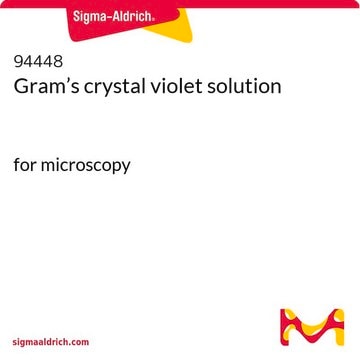61135
Crystal Violet
for microscopy (Bact., Bot., Hist., Vit.), indicator (pH 0.1-2.0)
Sinónimos:
Basic Violet 3, Gentian Violet, Hexamethylpararosaniline chloride, Methyl Violet 10B
About This Item
Productos recomendados
grade
for microscopy (Bact., Bot., Hist., Vit.)
indicator (pH 0.1-2.0)
Quality Level
form
powder
color
green to very dark green
visual transition interval
0.1-2.0, yellow-green to blue-violet
mp
205 °C (dec.) (lit.)
density
1.190 g/cm3
ε (extinction coefficient)
≥1750 at 585-595 nm in water
suitability
suitable for microscopy (Bact., Bot., Hist., Vit.)
antibiotic activity spectrum
fungi
application(s)
diagnostic assay manufacturing
hematology
histology
mode of action
cell membrane | interferes
enzyme | inhibits
storage temp.
room temp
SMILES string
[Cl-].CN(C)c1ccc(cc1)\C(c2ccc(cc2)N(C)C)=C3/C=C\C(C=C3)=[N+](/C)C
InChI
1S/C25H30N3.ClH/c1-26(2)22-13-7-19(8-14-22)25(20-9-15-23(16-10-20)27(3)4)21-11-17-24(18-12-21)28(5)6;/h7-18H,1-6H3;1H/q+1;/p-1
InChI key
ZXJXZNDDNMQXFV-UHFFFAOYSA-M
¿Está buscando productos similares? Visita Guía de comparación de productos
Categorías relacionadas
General description
Application
- Crystal violet is mainly used in Gram staining and its variants, and for staining amyloid, bacterial components, and vascular plant tissues.
- It is used in polychrome staining of epoxy resin sections, viability staining of cultured neurons, and confocal optical sectioning to analyze meiotic structures.
- It is also employed in the acridine orange-crystal violet staining of intracellular bacteria, microsporidian spores, and cytological smears.
Biochem/physiol Actions
Principle
signalword
Danger
hcodes
Hazard Classifications
Acute Tox. 4 Oral - Aquatic Acute 1 - Aquatic Chronic 1 - Carc. 1B - Eye Dam. 1 - Muta. 2
Storage Class
6.1C - Combustible acute toxic Cat.3 / toxic compounds or compounds which causing chronic effects
wgk_germany
WGK 3
flash_point_f
Not applicable
flash_point_c
Not applicable
ppe
Eyeshields, Faceshields, Gloves, type P3 (EN 143) respirator cartridges
Choose from one of the most recent versions:
¿Ya tiene este producto?
Encuentre la documentación para los productos que ha comprado recientemente en la Biblioteca de documentos.
Los clientes también vieron
Nuestro equipo de científicos tiene experiencia en todas las áreas de investigación: Ciencias de la vida, Ciencia de los materiales, Síntesis química, Cromatografía, Analítica y muchas otras.
Póngase en contacto con el Servicio técnico










